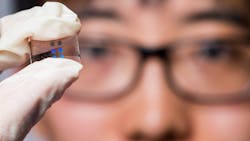Metasurface Optics: Metasurface camera lens to link between quantum computers and fiber-optic networks
If quantum computers realize their potential, they could lead to a new era in ultrasecure networks, artificial intelligence, and applied research (such as the development of new therapeutic drugs), and will be able to solve certain problems much faster than today’s classical computers. Numerous forms of quantum computer are based on photons and their entanglement (although by no means all are—others are based on entanglement of nuclear spins, Bose-Einstein condensates, or other phenomena).
However, the entangled photon states (nonclassical multiphoton interference) occurring in photonic quantum computers are difficult to cause and manipulate, conventionally requiring sequences of beamsplitters and other optics. In the past few years, metasurface lenses have been developed that can replace multiple optics in classical optical systems—the intriguing possibility arises that metasurface optics could simplify quantum-optical systems as well.
Now, an international team led by researchers at Australian National University (ANU; Canberra, Australia) has created a small camera lens based on optical metasurfaces that is aimed at facilitating links between quantum computers and fiber-optic networks.1 The team members hail from ANU, the University of New South Wales (Canberra, Australia), the University of Bristol (Bristol, England), National Central University (Jhongli, Taiwan), Oak Ridge National Laboratory (Oak Ridge, TN), and the University of Technology Sydney (Ultimo, Australia).
The lens is made of a 792-nm-thick polycrystalline silicon film on glass. The silicon is patterned to form rectangular pillars that vary in form and orientation, forming metagratings that are repeated across the aperture of the lens to form the metasurface. The new metasurface has the capability of decomposing and projecting photon states to any pairs of elliptical polarization states, creating enough diffracted polarization components to allow “on-off” click detectors to capture all the relevant state information (see figure).
The metasurface camera lens is highly transparent, thereby enabling efficient transmission and detection of information encoded in quantum light, says ANU associate professor Andrey Sukhorukov. Reconstruction of the photon states is immune to small fabrication defects, as was determined by a post-fabrication metasurface characterization done with classical light.
In the experiment, photons imaged by the metasurface lens were detected using two single-photon detectors, although the researchers say that an even-simpler setup relying on a single electron-multiplying CCD (EMCCD) camera could be used.
Reconstruction of photon states
The lens was used to image multiple projections of polarization-encoded quantum states, including their amplitude, phase, coherence, and entanglement. The two polarization-insensitive click detectors placed after the metasurface allowed reconstruction of one- and two-photon states—future experiments could reconstruct higher photon numbers.
Kai Wang, a Ph.D. scholar at ANU’s Nonlinear Physics Centre who worked on all aspects of the project, notes that one challenge was making portable quantum technologies. “Our device offers a compact, integrated, and stable solution for manipulating quantum light,” he says. “It is fabricated with a similar kind of manufacturing technique used by Intel and Nvidia for computer chips.” (In other words, the fabrication process is CMOS-compatible.)
The metasurface allows nonlocal single- and multiphoton correlation measurements without the requirement for photon-number-resolvable detectors, which require complex setups. The result is a small and robust optical setup that straightforwardly and accurately images photon states.
The research was conducted at ANU’s Nonlinear Physics Centre laboratories, where staff and postgraduate scholars developed and trialed the metasurface camera lens in collaboration with researchers at the Oak Ridge National Laboratory in the U.S. and the National Central University in Taiwan.
REFERENCE
1. K. Wang et al., Science (2018); doi:10.1126/science.aat8196.
About the Author
John Wallace
Senior Technical Editor (1998-2022)
John Wallace was with Laser Focus World for nearly 25 years, retiring in late June 2022. He obtained a bachelor's degree in mechanical engineering and physics at Rutgers University and a master's in optical engineering at the University of Rochester. Before becoming an editor, John worked as an engineer at RCA, Exxon, Eastman Kodak, and GCA Corporation.

